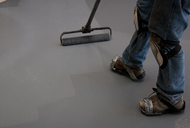In this article, we want to look at how cold temperature affects epoxy flooring and some tips for applying epoxy coating in this weather. You can get different results applying epoxy coating in the winter from when you apply in the summer and it’s very crucial that you understand the reason behind this so you are well prepared in advance.
Problems with Applying Epoxy Coating in Cold Temperatures
Pot Time
The number one thing we should look out for when we are applying epoxies in cold temperature is the pot life. The time the product requires to react is actually longer when you are applying in cold temperatures. This means you actually have a bit more time to work with the product, however, sometimes it can be so cold that this will affect recoat times. Cold temperatures can affect recoat windows and also the project completion time.
Humidity May be Higher
This is not a standard rule but in most cases what happens is in the winter you have high humidity that affects your condensation. The dew point in cold temperatures tends to be closer to the room temperature and this can lead to increase in relative humidity. This can cause moisture settling on the uncured epoxy. This can lead to reduced gloss, blushing, and surface defects on the floor.
Leveling
The third big problem with cold temperatures is leveling. What happens here is because the viscosity of the product and the flow of the epoxy are not as good when it’s cold it doesn’t settle and level properly. You may end up getting trowel marks or nail-marks and this is because it is so cold that the product just couldn’t flow and smoothen properly.
Tips for Applying Epoxy Coating in Cold Weather
Heat the Room in Advance
Heat the project area with conventional heaters or air conditioners so it’s easy to work on the floor but do not use propane-powered cannons or heaters. The reason is you can have problems with the propane fuse attacking the epoxy. This can leave funny-looking blotches and discolorations on the epoxy. So avoid using propane, you should rather go with some electrical heating methods.
Keep the Products Stored in Standard Room Temperature
It is a good idea to keep the products stored in a warm place so when you are applying them the actual temperature of the products is not that cold and that will definitely help with the leveling. Don’t keep them stored in a cold place where it will be freezing overnight or even close to freezing.
Add Some Solvent to the Mixture
You can also explore adding accelerators or solvents to your epoxy product to help improve the flow of the product. However, it will slow down your curing even more but at least it will solve the problem of leveling and the proper smoothening of the epoxy.
Most epoxy flooring products should be applied between 10 and 30°C which is about 50 to 86 Fahrenheit. Ideally, you want to be applying around 20 to 25 °C (68-77F) however, we never have ideal conditions as anyone who’s involved in epoxy flooring will tell you.
Benefits of Applying Epoxy Coating in Cold Weather
- Extended Pot LifeIn colder temperatures, the chemical reaction of epoxy slows down, which results in an extended pot life. This gives more working time, allowing you to properly adjust and apply the coating without rushing, ensuring a more precise application.
- Reduced Risk of Fast Curing MistakesIn warmer conditions, epoxy cures more rapidly, which can lead to uneven applications or rushed work. Cold weather offers more flexibility in handling the product, allowing for careful attention to detail.
- Lower Viscosity ControlWhile cold weather can increase viscosity, with proper preparation, such as heating the area or adjusting the product, you can still maintain the flow and control of the epoxy. This allows for better management of the leveling process.
- Improved Planning for Recoat WindowsWith the slower curing time, you have a longer window to apply additional coats. This extended recoat time ensures better adhesion between layers, enhancing the durability of the epoxy coating.
- Minimized Airborne ContaminantsCold weather typically means reduced airborne particles such as dust or pollen, which can lead to a cleaner application environment. This reduces the risk of surface contamination, helping achieve a smooth, defect-free finish.
By following proper preparation techniques, you can ensure successful epoxy applications even in colder conditions, minimizing potential issues and optimizing the final result.

